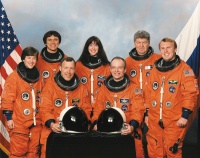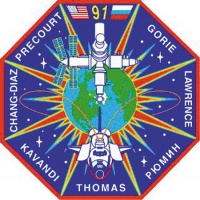STS-91
From The Space Library
 | |
| Organization | NASA-Office of Space Flight (United States) |
|---|---|
| Mission type | Human Crew,Microgravity |
| Launch date | June 2, 1998 |
| Launch vehicle | Space Shuttle |
| Launch site | Cape Canaveral, United States |
| COSPAR ID | 1998-034A |
| Inclination | 51.6 degrees |
| Experiments | Here |
| Alternate Names | 25356 |
| Additional Information | Here |
| Telecommunications Information | Here |
| Data Collection | Here |
| Payload Mass Up | 11758.02 kg |
| Payload Mass Down | 11867.73 kg |
| Orbiter | Discovery |
| Lift Off Mass | 2,052,050.00 kg |
| Orbiter Weight at Liftoff | 118,106.36 kg |
| Orbiter Weight at Landing | 102,398.18 kg |
| Landed | Concrete runway 15 at Kennedy Space Center, Fla. |
| Orbits of Earth | 155 |
| Orbital Altitude | 213 nautical miles (245 statute miles) |
Contents |
[edit] Crew
- Commander: Charles J. Precourt
- Pilot: Dominic L. Gorie
- Payload Commander:
- Mission Specialist 1: Franklin Chang-Diaz
- Mission Specialist 2: Wendy Lawrence
- Mission Specialist 3: Janet Kavandi
- Mission Specialist 4: Valeriy Ryumin, Russian Space Agency
- Mission Specialist 5:
- Payload Specialist 1:
- Payload Specialist 2:
ISS/Mir Crew Transport
- Andrew S.W. Thomas - down only
[edit] Mission
STS 91 was an American Shuttle spacecraft launched from Cape Canaveral. The main mission was to dock with and deliver goods to the Mir space station. It also carried the 3.5 ton international Alpha Magnetic Spectrometer to measure very high energy cosmic rays, and some resources for microgravity experiments. It docked with Mir on June 4 at 20:58 UT, undocked on June 8 at 16:02 UT and returned to Earth on June 12 at 18:00 UT. This mission was the first to use of the super lightweight external tank (SLWT) which is the same size (154ft long and 27ft in diameter) as the external tank used on previous launches but 7,500 lbs lighter. The tank is made of an aluminum lithium alloy and the tank's structural design also has been improved making it 30% stronger and 5% less dense. The walls of the redesigned hydrogen tank are machined in an orthogonal waffle-like pattern, providing more strength and stability than the previous design. These improvements will provide additional payload capacity to the International Space Station.
[edit] EVA
[edit] Payload
SPACEHAB 09 single module/Mir 09; orbiter docking system; getaway specials (8): G-090, G-743, G-765, G-648, two Space Experiment Modules (SEMs) (SEM 03 and SEM 05), two Phase 1 Program Support Packages (PH1 PSP1 and PH1 PSP2); Alpha Magnetic Spectrometer (AMS); Phase 1 requirements (Shuttle-Mir Mission 09 middeck science, mission support equipment and risk mitigation experiments); Commercial Protein Crystal Growth (CPCG); Solid Surface Combustion Experiment (SSCE); Shuttle Ionospheric Modification with Pulsed Local Exhaust (SIMPLEX, payload of opportunity
[edit] Books about the Space Shuttle Program
Buy This Book Click here |
Buy This Book here |
Buy This Book Click here |
Buy This Book Click here |





